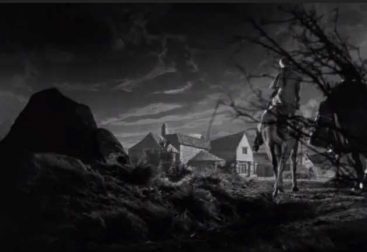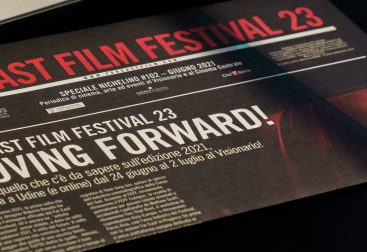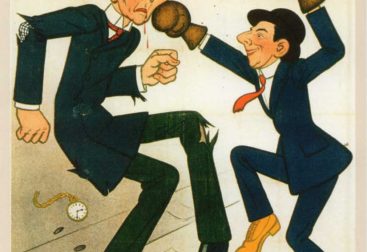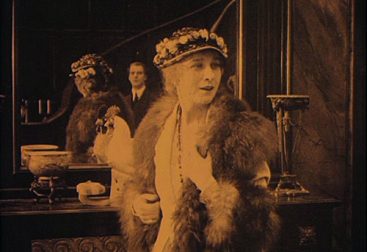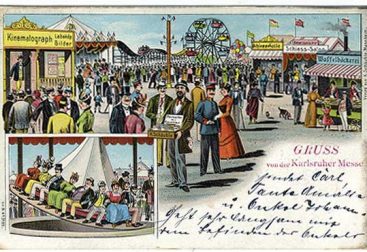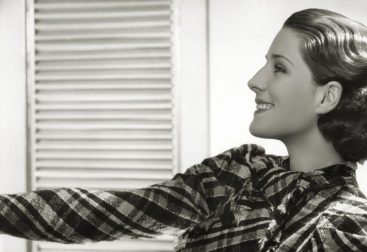(Traduzione italiana di seguito)
… is at least in my opinion the National Museum of Cinema in Turin. Probably I knew already before visiting the Berlinale in 2004 that there was a cinema museum in Turin. But it wasn’t until I saw the film “Dopo Mezzanotte” (After Midnight) by Davide Ferrario in the program of the International Forum of New Films that I spontaneously decided that I had to visit the Cinema Museum in Turin. “Dopo Mezzanotte” tells a love story, the protagonist is a student who works as a night watchman in the cinema museum. The actual protagonist of the film, however, is the Mole Antonelliana, in which the cinema museum is housed, or the museum itself. The film captures the magical atmosphere of the Mole Antonelliana and the museum so well that I not only became enthusiastic about the architecture of the building and the museum itself, but felt almost captured. However, it took a few more years before I was actually able to visit the museum after a hiking holiday on Monte Viso. My visit lasted many, many hours….
There are two reasons – still in my opinion – that I consider the cinema museum in the Mole Antonelliana to be the most beautiful that I know:
The first: the unique building that houses the cinema museum, the Mole Antonelliana.
The second: the design of the museum’s permanent exhibition and the principles on which it is based.
First about the building: The Mole Antonelliana is unique in many ways: A rectangular tower-like building with a slowly tapering dome. Inside there is a very high free space that almost reaches the top of the dome. Im Schnittpunkt der Diagonalen des Raumes schwebt ein Panoramaufzug nach oben zur Aussichtsplattform, die sich über der Kuppel in 85m Höhe befindet. This is followed by a pointed attachment that reaches a height of 167m. In good weather, the view extends as far as the Alps from the viewing platform.
The Mole, which means “large building” in Italian, was originally planned as a syngagogue. But the ambitious architect Alessandro Antonelli’s plans soon exceeded the financial resources of Turin’s Jewish community. Eventually the city of Turin took over the building, first setting up a museum of the Risorgimento there, until the cinema museum, founded by Maria Adriana Prolo, found its place in the Mole Antonelliana.
Why a cinema museum in Turin? To answer the question, a brief excursus into Italian film history is necessary. As the capital of Piedmont, Turin was also the seat of the Italian royal family. Turin was and is a rich city, not least because of the emergence of the automobile industry (Fiat). This is how Italy’s first film production companies such as Itala Film and Ambrosio came into being in Turin. Turin is the birthplace of Italian film, and it is therefore only logical that the Film Museum was established here.
I don’t want to write about further details of Italian film history and the importance of the Mole Antonelliana as one of the most famous and eye-catching landmarks of the city of Turin, because Maria Adorno can do better because she comes from Turin (see the following text).
So let’s get to the cinema museum:
The design of the permanent exhibition is – one could almost say – in a sophisticated way – geared towards its effect on the visitors. In fact, I wrote a first draft of this text as if I had found myself in the great temple hall after entering the museum. But that’s not right, as Maria Adorno told me. Visitors to the museum are first taken to a higher floor, where the part of the museum is located that is dedicated to the “cinema machine”. Then it goes through various stations on the sides of the high and open interior of the Mole Antonelliana downwards [wpml_nbsp] to the so-called chapels. At the same time, the view descends down into the hall, while at the same time you are exposed to an echo-like background noise, because in the high and free hall with its concrete walls you can hear the constant humming and humming of the voices of the visitors from everywhere. The chapels, which are located further down, are set up for the various Gernres, and only at the end of the tour do visitors find themselves in the large temple hall, which is dominated by the huge statue of Moloch from “Cabiria”. And that is the impression that visitors take home with them – this huge hall remains with them and I also remember it primarily. Whether it was actually the intention in the design of the exhibition to achieve this effect on the visitor can only be guessed at here. In any case, it had this effect on me. Provided that this statement can be generalized, the way in which the exhibition was successfully designed to achieve a certain effect can only be praised.
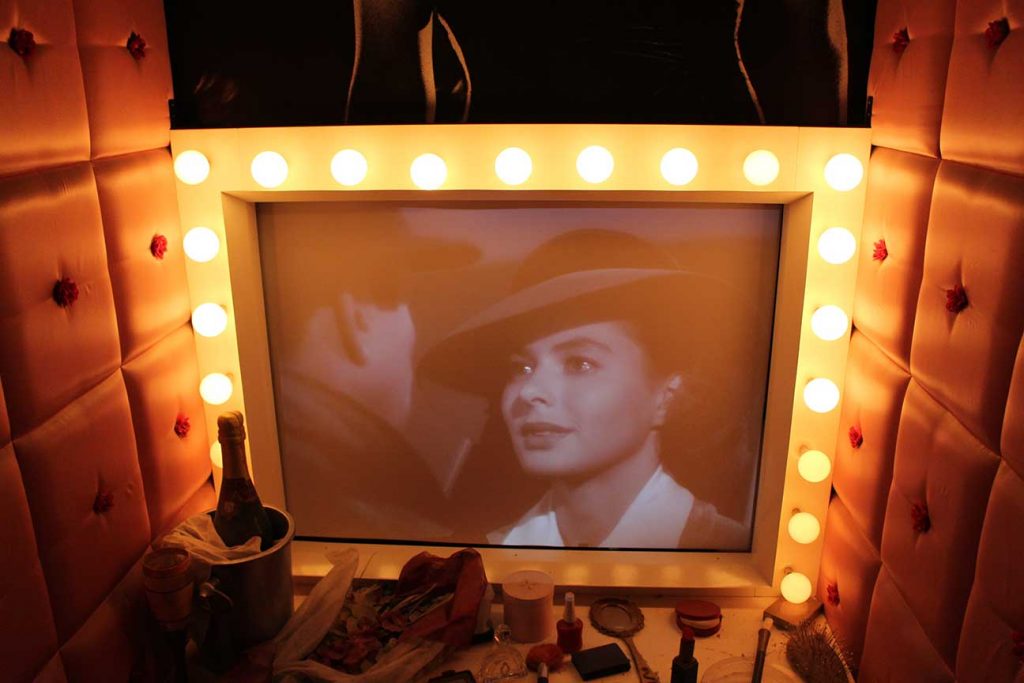
In the following, however, I do not want to follow the exact sequence of the visit, but rather wander around freely, just as I more or less did not stick to the suggested route at the latest on my second visit to the Turin Film Museum and wanted to get lost in the exhibition …
So let’s first talk about the temple hall, which occupies the very high and free interior. The name not only alludes to the original purpose of the building, but also makes a reference to film history. As already mentioned, a replica of the newt from “Cabiria” is clearly visible here. Fortunately, there are no hard pews waiting for the visitor in the temple hall, but very comfortable, somewhat futuristically designed loungers, so that one can quietly watch two film montages. One could now philosophize about whether a certain cinephilia, also tending towards the religious, comes into play here, because the smaller side rooms, which are dedicated to individual genres, are also called “chapels” in the English-language brochure of the museum. Of course, it was Italian cinema that also invented the type of “diva”, the goddess, of those actresses who were practically religiously revered such as Lyda Borelli, Pina Menichelli and others. We only know “stars”. …
In fact, the principle that clearly comes into play in the design of the permanent exhibition is a great love of cinema in all of its facets. While many other cinema museums have chosen a more cognitive approach to cinema and film history, which always keeps visitors at a certain reflexive distance and “teaches” them film history, for me the pleasure and sensuality increased steadily over the course of the visit Enjoyment to the extent that I stayed at the various stations for a long time and almost lost myself in the exhibition. In “Frankenstein’s Laboratory” there is a wonderful bubble in an imaginative laboratory setting, and in the western bar one is afraid of having to breathe a lot of lead-laden air. You almost think that Doc Holliday is about to walk in with Wyatt Earp, and it occurs to me that I really want to write something about “My Darling Clementine” – although – or maybe – because I’m not actually a fan of westerns. I digress … Back to Turin …
In all these chapels – [wpml_ nbsp] and only a small number of them are mentioned here – [wpml_nbsp ] monitors offer film excerpts, and the corridors between the individual stations, which are grouped around the large interior, are partly huge Decorated posters of well-known and famous films. The science fiction chapel, where you can take a seat in an interstellar pilot’s chair, is just as successful, and finally there is also the chapel of the absurd, which is based on a scene from Bunuel’s “Le Fantôme de la liberté´” (The Specter of Freedom) is designed.
As already mentioned, on a higher floor of the pier, visitors are introduced to what I would like to call the “cinema system”, which ranges from the production of a film to its distribution. In the National Museum of Cinema Turin, this department has been given the name “The Cinema Machine”, which in turn is an allusion to the way a film is made based on the division of labor, which can certainly be compared with industrial production. It is not for nothing that people talk about the film industry. In this part of the museum, too, the individual stations, such as B. “The director” or “The script”, but also the characteristic features of the “system cinema” designed in detail and with great attention to detail. Let’s just mention pars pro toto “The star system”, “The casting of the actresses” to “The camera”, “The lighting” and other technical aspects.

Let’s try a résumé: As a creative force that rules all departments of the Turin Film Museum, only a great love for cinema can be located. The cinephilia, which is effective and effective everywhere in Turin, does not exclude anything and allows all forms of cinema to remain valid. In this way, the cinema can unfold its full magic and a visit to the Nation Museum of Cinema in Turin becomes a unique sensual experience. A visit that many visitors will probably be happy to repeat. I look forward to my third visit longingly. And now Maria Adorno has the floor.
All photos: © Josef Jünger
Il più bel museo del cinema del mondo
…… è il Museo Nazionale del Cinema di Torino, almeno a parer mio. Probabilmente sapevo già prima della mia visita alla Berlinale nel 2004 che a Torino c’era un museo del cinema, ma è stato solo dopo aver visto il film “Dopo Mezzanotte” di Davide Ferrario al “Internationalen Forums des Jungen Films” che ho deciso spontaneamente di andarlo a visitare. “Dopo Mezzanotte” racconta una storia d’amore il cui protagonista è uno studente che lavora come guardiano notturno al Museo del Cinema. Il vero protagonista del film, però, è laMole Antonelliana, se non addirittura lo stesso Museo. Il film cattura così bene l’atmosfera magica della Mole Antonelliana e del Museo del Cinema che, oltre ad aver trovato sorprendenti l’architettura dell’edificio e del Museo, mi sono sentito davvero catturato dal loro fascino. Tuttavia, ci sono voluti alcuni anni prima che potessi effettivamente visitare il Museo, in seguito ad un’escursione sul Monviso. La mia visita è durata molte, molte ore…
Ci sono due ragioni per cui io, personalmente, considero il Museo del Cinema della Mole Antonelliana il più bello tra quelli che conosco:
Innanzitutto, lo straordinario edificio in cui è ospitato il Museo del Cinema, la Mole Antonelliana;
a seguire, la struttura della mostra permanente e i principi su cui si basa.Iniziamo dall’edificio.
La Mole Antonelliana è unica in svariati sensi: è un edificiosu base quadrangolare simile ad una torre, si sviluppa con una cupola che poi si assottiglia progressivamente. All’interno c’è uno spazio aperto molto alto che arriva quasi alla sommità della cupola. All’incrocio delle diagonali di quest’area, un ascensore panoramico sale fino alla terrazza panoramica, che si trova a 85m al di sopra della cupola. Segue la lunga punta dell’edificio, la cui sommità raggiunge un’altezza di 167m. Con il bel tempo, la vista dalla terrazza panoramica si estende fino alle imponenti Alpi.
La Mole, che letteralmente indica un edificio dalla possente “massa”, era stata originariamente progettata come una singagoga. Ma i piani dell’ambizioso architetto Alessandro Antonelli oltrepassarono presto le risorse finanziarie della comunità ebraica torinese. Alla fine la città di Torino rilevò l’edificio, allestendovi dapprima un Museo del Risorgimento, finché il Museo del Cinema, fondato da Maria Adriana Prolo, vi trovò posto.
Ma perché un Museo del Cinema a Torino? Per rispondere alla domanda è necessario un breve excursus nella storia del cinema italiano. Come capoluogo del Piemonte, Torino era anche la sede della famiglia reale italiana. Torino era ed è una città ricca, non da ultimo per l’emergere dell’industria automobilistica della Fiat. Nascono così a Torino le prime società di produzione cinematografica italiane come Itala Film e Ambrosio. Torino è la culla del cinema italiano, ed è quindi logico che il Museo del Cinema sia stato istituito qui. Non voglio scrivere ulteriori dettagli riguardo la storia del cinema italiano e l’importanza della Mole Antonelliana in quanto uno dei simboli più famosi e suggestivi della città di Torino, perché Maria Adorno, essendo Torinese, può senza dubbio farlo meglio di me (vedi il testo che segue).

Veniamo quindi al Museo del Cinema: il design della mostra permanente è, oserei dire con grande raffinatezza, orientato al suo effetto sui visitatori. In effetti, avevo scritto una prima bozza di questo testo basandomi sui miei ricordi, che mi suggerivano che all’entrata ci si trovasse già nella maestosa Sala del Tempio. E invece, come mi ha fatto notare Maria Adorno, i visitatori del Museo vengono prima condotti in un’altra sezione, dove si trova la parte del Museo dedicata alla “macchina del cinema”. In seguito, si attraversano varie aree interne percorrendo gli ampi lati interni della Mole Antonelliana, fino alle cosiddette cappelle. Durante il percorso, lo sguardo è già attratto dall’atrio centrale, e allo stesso tempo si è esposti ad un rumore di fondo simile ad un eco,poiché dall’atrio, ampio e aperto, delimitato da pareti in cemento, si percepisce il ronzio costante delle voci dei visitatori venuti da ogni dove. Le cappelle, che sitrovano più in basso, sono allestite secondo vari generi cinematografici, e solo a questo punto del percorso i visitatori si trovano nella grande Sala del Tempio, dominata dall’enorme statua del Moloch di “Cabiria”. E questa è l’impressione che i visitatori portano a casa con loro: questa enorme sala rimane impressa, ed era infatti indubbiamente il ricordo privilegiato dalla mia memoria. C’è da chiedersi se il suscitare questo effetto nei visitatori fosse effettivamente l’intenzione dell’allestitore della mostra. Di certo, questo è stato l’effetto su di me. E se questa impressione fosse effettivamente generalizzabile, allora non si può che elogiare il modo in cui la mostra è stata progettata, con successo, in funzione di un determinato effetto.
A questo punto, però, preferisco abbandonare l’esatta sequenza della visita e vagabondare liberamente, così come non mi sono streattamente attenuto al percorso suggerito quanto ho visitato per la seconda volta il Museo del Cinema di Torino, e ho preferito perdermi nella visita…
Tornerei quindi alla Sala del Tempio, che occupa la zona interna, ampia e libera.Il nome non solo allude allo scopo originario dell’edificio, ma fa anche riferimento alla storia del cinema. Come già accennato, qui è chiaramente visibile una replica del Moloch di “Cabiria”. Fortunatamente, poi, nell’area centrale lo spettatore non trova dei banchi rigidi da chiesa su cui sedersi, ma delle poltroncine molto comode, quasi futuristiche, su cui ci si può sdraiare e si può tranquillamente godere di alcuni montaggi cinematografici su due schermi l’uno vicino all’altro. Si potrebbe ora filosofare se come una certa cinefilia, che tende anche ad essere religiosa, entra qui in gioco, poiché le stanze ausiliarie più piccole, quelle dedicate ai singoli generi, sono chiamate “cappelle” anche nelle brochure in inglese del Museo. Certamente, è stato il cinema italiano ad inventare il modello di “diva”, la dea, di quelle attrici che erano venerate in modo quasi religioso, come Lyda Borelli, Pina Menichelli, e molte altre. Conosciamo solo “stelle”…
In effetti, il principio che chiaramente entra in gioco nella progettazione della mostra permanente è un grande amore per il cinema in tutte le sue sfaccettature. Mentre molti altri musei del cinema hanno scelto un approccio più cognitivo alla storia del film e del cinema, che tiene automaticamente i visitatori ad una certa distanza riflessiva e “insegna” loro la storia del cinema, qui ho provato davvero un senso di diletto; e questo piacere sensoriale è aumentato così tanto, durante la visita, da farmi rimanere a lungo nelle varie stazioni e farmi davvero sperdere nella mostra. Nel “Laboratorio di Frankenstein” si gorgoglia meravigliosamente in un ambiente di laboratorio fantasioso, mentre nel locale in stile Western si ha quasi timore di dover davvero respirare un’aria carica di piombo. Si ha l’impressione che Doc Holliday stia per entrare con Wyatt Earp – il che mi fa venire in mente che voglio proprio scrivere qualcosa su “My Darling Clementine”, anche se in realtà non sono un fan dei western – o forse proprio per questo. Ma non divaghiamo e torniamo a Torino…

In tutte queste cappelle – e qui ne ho menzionate solo alcune – svariati monitor offrono estratti di film, mentre i corridoi tra le singole stanze, che sono raggruppati attorno al grande atrio interno, sono spesso decorati con enormi poster di film famosi e prestigiosi. La cappella della fantascienza, dove ci si può sedere sulla poltrona di un pilota interstellare, è altrettanto suggestiva, e infine c’è anche la cappella dell’assurdo, che sostanzialmente si basa su una scena de “Le Fantôme de la liberté ́” di Buñuel.
Come dicevo, al piano superiore della Mole i visitatori vengono introdotti a quello che mi piace chiamare “sistema cinema”, che va dalla produzione di un film alla sua distribuzione. Nel Museo Nazionale del Cinema di Torino, a questo reparto è stato dato il nome “La macchina del cinema”, che a sua volta allude al modo in cui si realizza un film basato sulla divisione del lavoro, che può certamente essere paragonato alla produzione industriale. L’industria cinematografica non viene però trattata. Anche in questa parte del museo le singole stazioni, come “Il regista” o “La sceneggiatura”, nonché i tratti caratteristici del “sistema cinema”, vengono presentati tutti con grande attenzione ai dettagli. Tra i tanti aspetti tecnici trattati, cito pars pro toto lo Star System, il Casting, la videocamera, l’Illuminazione.
Proviamo a riassumere: penso che l’impulso creativo che regna in tutte le sezioni del Museo del Cinema di Torino è essenzialmente il grande amore per il cinema. La cinefilia, che si fa sentire ovunque a Torino, non esclude nulla e conferisce ad ogni forma di cinema la propria validità. In questo modo il cinema può dispiegare tutta la sua magia, e così una visita al Museo del Cinema di Torino diventa un’esperienza sensoriale unica nel suo genere. Una visita che molti visitatori sono probabilmente felici di ripetere. Io attendo con ansia la mia terza visita. E ora lascio la parola a Maria Adorno.
Tutte le foto: © Josef Jünger
Traduzione: Maria Adorno
[fvplayer id=”1″]
The video gets lost a little in the heights and further on of the temple hall


